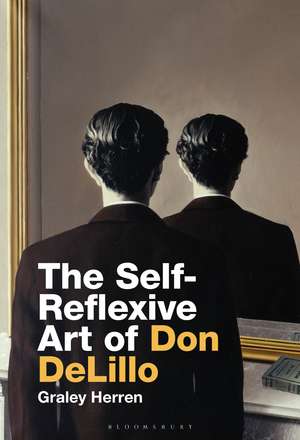The Self-Reflexive Art of Don DeLillo
Autor Prof Graley Herrenen Limba Engleză Paperback – 23 dec 2020
| Toate formatele și edițiile | Preț | Express |
|---|---|---|
| Paperback (1) | 218.47 lei 6-8 săpt. | |
| Bloomsbury Publishing – 23 dec 2020 | 218.47 lei 6-8 săpt. | |
| Hardback (1) | 773.81 lei 6-8 săpt. | |
| Bloomsbury Publishing – 26 iun 2019 | 773.81 lei 6-8 săpt. |
Preț: 218.47 lei
Preț vechi: 275.30 lei
-21% Nou
Puncte Express: 328
Preț estimativ în valută:
41.80€ • 43.76$ • 34.59£
41.80€ • 43.76$ • 34.59£
Carte tipărită la comandă
Livrare economică 07-21 aprilie
Preluare comenzi: 021 569.72.76
Specificații
ISBN-13: 9781501376153
ISBN-10: 1501376152
Pagini: 288
Dimensiuni: 152 x 229 x 20 mm
Greutate: 0.39 kg
Editura: Bloomsbury Publishing
Colecția Bloomsbury Academic
Locul publicării:New York, United States
ISBN-10: 1501376152
Pagini: 288
Dimensiuni: 152 x 229 x 20 mm
Greutate: 0.39 kg
Editura: Bloomsbury Publishing
Colecția Bloomsbury Academic
Locul publicării:New York, United States
Caracteristici
Identifies and analyzes the pervasive theme of the embedded author in DeLillo's novels
Notă biografică
Graley Herren is Professor and Chair of English at Xavier University, USA. He is the author of Samuel Beckett's Plays on Film and Television (2007). He is editor of five volumes in the Text & Presentation book series.
Cuprins
Preface Acknowledgments List of Abbreviations 1. How to Make Metafiction: A Genealogy for Don DeLillo's Self-Reflexive Art 2. American Narcissus: Lacanian Reflections in Americana 3. Libranth: Nicholas Branch's Joycean Labyrinth 4. "The Martiniad": Nick Shay as Embedded Author in Underworld 5. The Artistic Gestation of Klara Sax 6. Performing Self-Dialogue in "The DeLillo Variations" 7. Art Stalkers 8. Literary Triangulation: DeLillo - O'Hara - Oates 9. A Miniature Star: Remains and Returns in the Metafiction of Zero K 10. A Portrait of the ARTIS: Jeff Lockhart as Embedded Author in Zero K Coda Bibliography Index
Recenzii
Herren (Xavier Univ.) analyzes a metafictional motif that permeates DeLillo's entire body of work-mirrors or mirrored realities. He argues that DeLillo and DeLillo's artist/narrator characters create fictional worlds and represent reality through their art. He also contends that spectators within DeLillo's works, as in reality, project their personal preoccupations onto art, thereby making art as self-reflexive for observers as it is for the artists who create it. Herren chooses to investigate self-reflexivity in what he deems the most relevant of DeLillo's texts: he dedicates two chapters apiece to Underworld and Zero K and in other chapters focuses on Americana, Libranth, and later works. In a creative turn at the book's end, Herren offers a coda in which he recounts a pertinent dream regarding DeLillo and his work. Extensive endnotes elaborate on points throughout the text. Summing Up: Recommended
The Self-Reflexive Art of Don DeLillo provides a framework and insights that are highly interesting, original, and readable, while at the same time being intensive, developed, and deep. DeLillo's work benefits from Graley Herren's effective combination of strong close reading as well as his varied, sophisticated theoretical lenses, which demonstrate the many ways in which DeLillo's fiction both reflects our, and creates its own, world.
Graley Herren provides accessible, elegant proof of yet another set of themes and methods woven into DeLillo's astoundingly intricate art. Through close analysis of both well-known and underappreciated texts, Herren reveals how the multifaceted metaphor of mirrors has served DeLillo in fascinating, virtually innumerable ways, and that his self-reflexive depictions of artists and the creative process constitute a career-long argument for the salvific potential of art itself.
A welcome addition to the DeLillo shelf, it should rank with the indispensable studies of this author. Original, fresh, and at times startling, Herren's readings are enhanced by his scrupulous attention to prior DeLillo criticism. One sees considerable tracts of the now vast scholarly conversazione succinctly laid out, celebrated, and resourcefully augmented.
The Self-Reflexive Art of Don DeLillo provides a framework and insights that are highly interesting, original, and readable, while at the same time being intensive, developed, and deep. DeLillo's work benefits from Graley Herren's effective combination of strong close reading as well as his varied, sophisticated theoretical lenses, which demonstrate the many ways in which DeLillo's fiction both reflects our, and creates its own, world.
Graley Herren provides accessible, elegant proof of yet another set of themes and methods woven into DeLillo's astoundingly intricate art. Through close analysis of both well-known and underappreciated texts, Herren reveals how the multifaceted metaphor of mirrors has served DeLillo in fascinating, virtually innumerable ways, and that his self-reflexive depictions of artists and the creative process constitute a career-long argument for the salvific potential of art itself.
A welcome addition to the DeLillo shelf, it should rank with the indispensable studies of this author. Original, fresh, and at times startling, Herren's readings are enhanced by his scrupulous attention to prior DeLillo criticism. One sees considerable tracts of the now vast scholarly conversazione succinctly laid out, celebrated, and resourcefully augmented.
